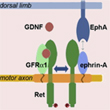Tuesday, 18 June 2013
Proteins That Guide the Wiring of the Brain

The human brain has millions of times more connections between its neurons than the number of genes (roughly 20 000 to 25 000) in the DNA of these cells. And yet, when the brain is developing, the tips of the axons of its growing neurons act like veritable homing devices, successfully seeking out their specific targets in the complex molecular soup that constitutes the extracellular environment.
Scientists have long known that these targets produce molecules that are detected by receptors on the axons’ growth cones and guide them to their targets. But only recently did a team at the Salk Institute in California discover how just a handful of genes enable the guidance processes by which the brain’s complex wiring is established.
The small number of proteins manufactured by these genes arrange themselves into “coreceptors” that can integrate multiple molecular signals and translate them into coherent navigational instructions for the axons’ growth cones.
The Salk Institute study dealt with motor neurons in mice. The axons of these neurons must emerge from the spinal cord and travel to the right muscles in the animals’ paws. But there is a very high likelihood that, as in many other cases, the same mechanisms at work here in the peripheral nervous system also operate in the central nervous system, thus providing one more key to understanding how growing axons navigate in the right direction.
![]() Complex Wiring of the Nervous System May Rely on Handful of Genes and Proteins
Complex Wiring of the Nervous System May Rely on Handful of Genes and Proteins
![]() Ret Is a Multifunctional Coreceptor that Integrates Diffusible- and Contact-Axon Guidance Signals
Ret Is a Multifunctional Coreceptor that Integrates Diffusible- and Contact-Axon Guidance Signals
How the Mind Develops | Comments Closed








